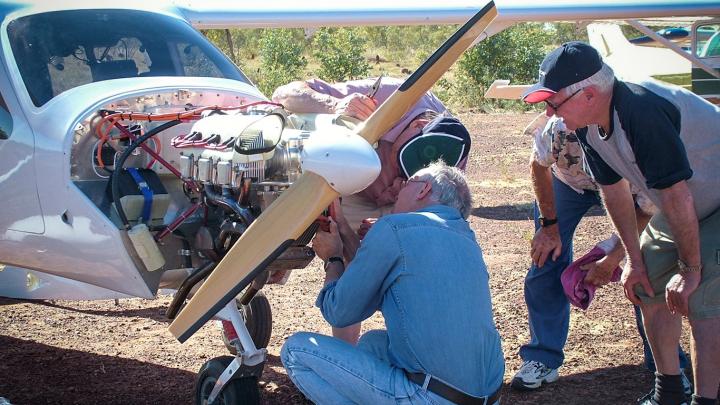A safe and hassle-free flight has its foundations in good maintenance. If the aircraft won't fly, you aren't going anywhere.
Safety is the obvious factor but, make no mistake, it is a hassle when things go wrong with your aircraft. A time-consuming, often expensive and trip-wrecking hassle.
There are complex defects and incidents, such as a propeller strike, that only a Licenced Aircraft Maintenance Engineer (LAME) can assess and rectify. But there are some avoidable problems that can otherwise have huge safety implications.
Think about a blocked pitot tube just as you take off at somewhere like Forrest in the middle of the Nullarbor or a rough running engine and unacceptable magneto drop, a vacuum pump failure, a flat battery, or a punctured tyre.
The nearest maintenance organisation is at Kalgoorlie, over 340 nautical miles away. A rescue mission to your current remote location guarantees all kinds of woe.
A rescue may involve linking up an available LAME who has the parts for your aircraft. After hours of delay, they arrive with a box of parts. But you eventually come to find that the problem as explained over the phone is not the real problem at all.
We're not suggesting you can prevent all mechanical failures or that you need to attempt every maintenance action a pilot can perform on an aircraft. But you can certainly go a long way towards reducing the likelihood of a maintenance issue if you follow the advice and guidelines available.
Common maintenance issues
While we are all taught to give to a thorough daily inspection, incident and accident reports constantly point to avoidable airworthiness issues.
Here are a few common issues have caught the unwary as they launched into the great outdoors. They include:
- water contaminating the fuel (AWB 28-008). Also read AWB 28-003 on using the correct fuel
- wasps nesting inside the pitot tube and fuel vents (AWB 02-052, AWB 28-013)
- wrong fuel/rubber hose combination. (AWB 02-006)
- pilots conducting maintenance they have permission to do but know nothing about. ATSB report AO-2013-174 details a fatal accident attributed to the loss of one spark plug. This was a result of the actions of a pilot who was inexperienced in maintenance
- a dud Emergency Locator Transmitter (AWB 02-002).
You can also read our Airworthiness Bulletins for background.
ATSB advises 'ongoing safety requires aircraft owners and maintainers to operate and maintain an aircraft in accordance with relevant regulations, including those specific to experimental aircraft. While the regulations allow for an experimental aircraft builder to be granted approval to conduct ongoing maintenance, the builder must have sufficient engineering skill and knowledge.'
A few pieces of sound advice include:
- always think about the effects the environment may have on an aircraft
- raise your standards with regard to knowing your aircraft and its systems
- be vigilant in your inspection of the aircraft. Don't allow yourself to get distracted, and remain alert for elements that just look, sound, smell or feel - wrong. Use all your senses
- give your utmost attention to fuel management and refuelling
- promise yourself when you feel a nagging doubt about the full serviceability of your aircraft, shut down the engine and remove the key. Once all is well, turn it back on.
Aircraft undergoes propellor maintenance
Maintenance resources
Here is a range of resources in aircraft maintenance.
CAAP 43-01 Maintenance release (CAR 43)
CAAP 43-01 features information about defects and their rectification since the issue of the maintenance release. It also covers maintenance required before the next 100 hourly inspection:
CAAP 42B-1 CASA maintenance schedule
CAAP 42B-1 provides information and guidance to support the manufacturer's maintenance schedule. The following should be read together:
Note: the CASA Maintenance Schedule is CASA Schedule 5. This is the generic maintenance schedule many aircraft operators have elected to use to maintain their aircraft. You use this instead of the manufacturer's schedule.
Remember that Schedule 5 is just a list of maintenance tasks that may not be suitable for your aircraft. You can find the intelligence to do the tasks in the manufacturer's data. You must accomplish all maintenance in accordance with approved data.
CAAP 42ZC-01 Schedule 8 pilot maintenance
This schedule lists the maintenance actions for pilots allowed to complete under sub regulation 42ZC(4):
Never attempt any maintenance action which may be listed in the Schedule but for which you have not been trained. Again, all maintenance must be accomplished in accordance with the approved data.
CAAP 50A/B-1 Aircraft logbooks
CAAP 50A/B-1 records the aircraft maintenance history for the:
- engine
- airframe
- propeller.
It also includes maintenance history for the compliance with Airworthiness Directives and all critical parts installed in the aircraft:


